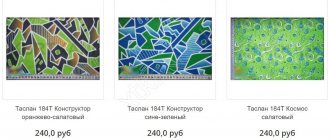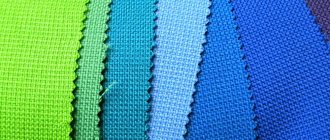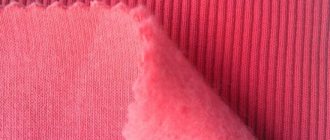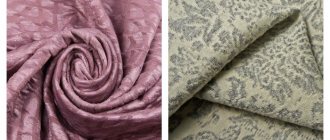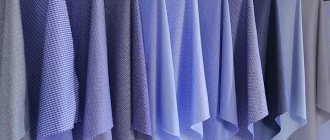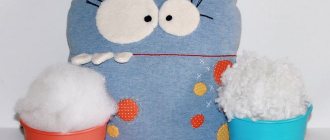There is a huge variety of fabrics. Making a choice towards the one can be difficult. We talked about oil fabric, what kind of material it is and all the most important things about it.
Characteristics
What kind of fabric is oil? In fact, it is a knitted material with the addition of synthetic elements.
The material oil has distinct qualities for knitwear. Here are some of them:
- Oil with the addition of synthetic threads has low creasing properties. If viscose predominates in the composition, then, on the contrary, creases and folds form very quickly even with careful wear.
- Resistant to the formation of pellets on the surface. The fabric is durable and very difficult to make snags on.
- High hygroscopicity. What is hygroscopic fabric? This is high absorbency and comfort in the heat. This applies to viscose oil; synthetic oils absorb moisture much worse.
- Breathability. As in the previous case, only “natural” oil has this quality.
- Neat edges without crumbs. Due to its “knitting” technology, the edge line is neat and even.
- Elasticity. Does it stretch or not? Of course, like any knitwear, oil hugs the figure in the right places, emphasizing its advantages.
Video review of oil fabric (cold knitwear)
The video shows butter polyester knitwear with a bright, beautiful, rich pattern. This fabric is easy to drape, but difficult to sew; you always need to process the cuts. Knitwear is suitable for thick, heavy dresses, skirts, and sweaters.
See similar articles
- Corduroy is a durable textured fabric with a soft texture.
- Milano - dense soft knitted fabric
- Velvet - fabric with dense pile on the front side
- Elastane is a durable material that makes the fabric elastic
- Velor - soft fabric with pile, for clothing and interior
- Twill is a durable blended fabric that is soft to the touch.
If you liked the article, share it with your friends!
Manufacturing and composition
Instead of the usual creation of fabric on a machine, the butter is knitted with one thread: either viscose or synthetic.
A mandatory component of the fabric is spandex, the content of which must be at least 8%.
It gives the material elasticity and helps it stretch in all directions.
Based on its composition, oil is divided into three main types:
- Viscose. The viscose content is 90%, and the remaining ten is spandex.
- Polyester. Up to 90% is polyester, the rest is unchanged spandex.
- Mixed. Here the variety lies in changing the ratio of viscose to synthetic threads. An even distribution of both sides is popular.
All types differ in properties, depending on the predominant component. Blended oil has equal qualities from synthetic and viscose material, which makes it much more practical.
What does knitwear look like?
Despite the high density, the material is soft and silky. It is 70% viscose and 30% polyester. The fabric is elastic and fits perfectly to your figure.
allows air to pass through and does not cause discomfort or irritation on the skin. The material is durable and wear-resistant, does not fade in the sun, and does not stretch over time. Oil does not form pills on knitwear.
The appearance and properties of this fabric vary depending on its type:
- Classic - has a dense structure and matte surface, excellent air permeability.
- Cold - less dense material with a glossy surface. The fabric is used for sewing elegant dresses.
- Micro-oil is the lightest and most elastic type of oil knitwear. Summer clothes are made from it.
- Crystal - Lycra and polyester are added to the composition. The fabric has a flowing structure and shine.
- Winter oil has the highest density. The material is used for the manufacture of demi-season and winter outerwear.
- Brushed - knitwear with a glossy surface and viscose fluff on the reverse side. It is suitable for sewing comfortable and practical things - tracksuits, pajamas and dressing gowns.
- Oil foam is a lightweight fabric with a glossy surface that does not require ironing. This is an excellent material for sewing casual clothes.
Varieties
If you dig deeper, you can see that the diversity of species is much greater than just three.
All types differ in composition, method of knitting and application.
Here are the most common of them:
- Winter oil. Due to the predominance of viscose, it has a slight shine and a soft, velvety structure on the front side.
- Chill. The material got its name for the cool sensation it feels when in contact with the skin. The threads in this fabric are thin and without a pronounced texture, so in the end the oil looks like light silk. Easily breathable fabric is used for sewing summer clothes.
- With fleece. The front side and feel are similar to winter oil, since the composition contains a high content of viscose threads. Most of them are concentrated on the underside so that a thin but warm layer of down is obtained.
- Micro oil fabric. When creating, a special weave and fibers of different thicknesses are used. The fabric turns out weightless and very soft. It is mainly used to make summer clothes and light blouses.
- Venice. Lightweight and silky material made from synthetic elements.
- Crystal. Its peculiarity is a uniform smooth surface on one side and an uneven rough surface on the other (wrong side), it can be seen in the photo close up.
Types of fabric
There are a number of fabrics called oil textiles that have specific properties:
- Classic oil. Durable, good stretch matte material.
- Cold. The finest type of oil, used for sewing decorative items and summer clothing.
- With fleece. A warmed version of the classic oil.
- Micro oil. Has high elasticity and breathability.
- Crystal. A glossy variety of oil-textile.
- Crepe butter. Rough textiles that do not wrinkle and do not require ironing.
- Viscose oil. Heavy type of knitwear due to the high percentage of viscose content. It has a flowing texture; when worn, small folds remain on the fabric.
- Winter oil. It has a glossy color and is resistant to deformation after washing.
- Printed. Classic oil with print, ornament or painted pattern.
- Oil-foam. Durable, dense synthetic product in matte colours.
Advantages and disadvantages
This knitted material is very competitive. Let's consider its advantages:
- Gently fits the figure, as it contains lycra.
- Has high drapability. Folds and flounces flow gently, while maintaining a neat rounded shape. Fashion designers often use this when sewing floor-length evening dresses.
- Durable. Does not lose its properties with active wear.
- Resistantly colored and not subject to color fading over time.
- Soft. Does not rub even when fitted tightly and is suitable for sensitive skin.
Like any other material, oil is not without its drawbacks. Here are the most significant of them:
- Synthetic fabric can cause irritation for allergy sufferers and hypersensitive people.
- If you do not wash your clothes in a washing machine on a delicate cycle, damage to the structure may occur.
- Poor thermoregulation. In cold weather it will be cold, and in hot weather it will be hot.
Application of knitwear
Due to its species diversity and numerous advantages, this knitted material is widespread in Russia.
Initially, airy fabric received its calling in the East, where a universal fabric was required for sewing comfortable clothes for hot weather.
Summer suits, sundresses, skirts and blouses are made from thin and airy oil. Evening dresses with numerous flounces and pleats are also made.
Thick oil is used to make dressing gowns, tracksuits and comfortable pajamas and trousers. For evening suits, dense crystal is used.
How to sew butter from knitwear
The high elasticity of the canvas can cause some incidents when working with oil, here are some tips to avoid them in advance:
- Measure a tight-fitting model according to “naked” measurements.
- Try on several times while sewing as the fabric may be slightly warped.
- Darts on the chest are not made as it is unnecessary.
- If necessary, darts are made at the waist and back.
- Sew on an overlocker.
- Do not use duplicate materials to get the most out of the elasticity.
- Place a knit stitch.
- When sewing models with cut-off waists, do not forget to insert silicone tape to maintain the original shape.
Care instructions
To keep your clothes looking presentable longer, you should follow the care recommendations. Here are the main ones:
- Wash clothes in a washing machine only on a delicate cycle with a water temperature of 40°. Hand wash can be used.
- Do not store with sharp or rough objects to avoid nicks and holes.
- Do not use bleaching or aggressive agents when washing.
- When washing, use liquid gels for colored laundry.
- Dry on a horizontal surface or hanger, squeezing the laundry by hand.
- Iron on the silk setting (no more than 110°), you can do without ironing at all.
How to care for clothes made from knitwear fabric
Some tips on caring for such items from our online store of plus size women's clothing:
- Products should be washed by hand at a water temperature of no more than 40°C or in the delicate mode of a washing machine. Do not use powders containing aggressive substances.
- It is advisable to dry items on hangers, and iron slightly damp on the reverse side, heating the iron no higher than 110 degrees.
Our online store will help you buy large size women's clothing wholesale. Goods are delivered throughout Ukraine, Russia, Kazakhstan, Belarus and European countries.


